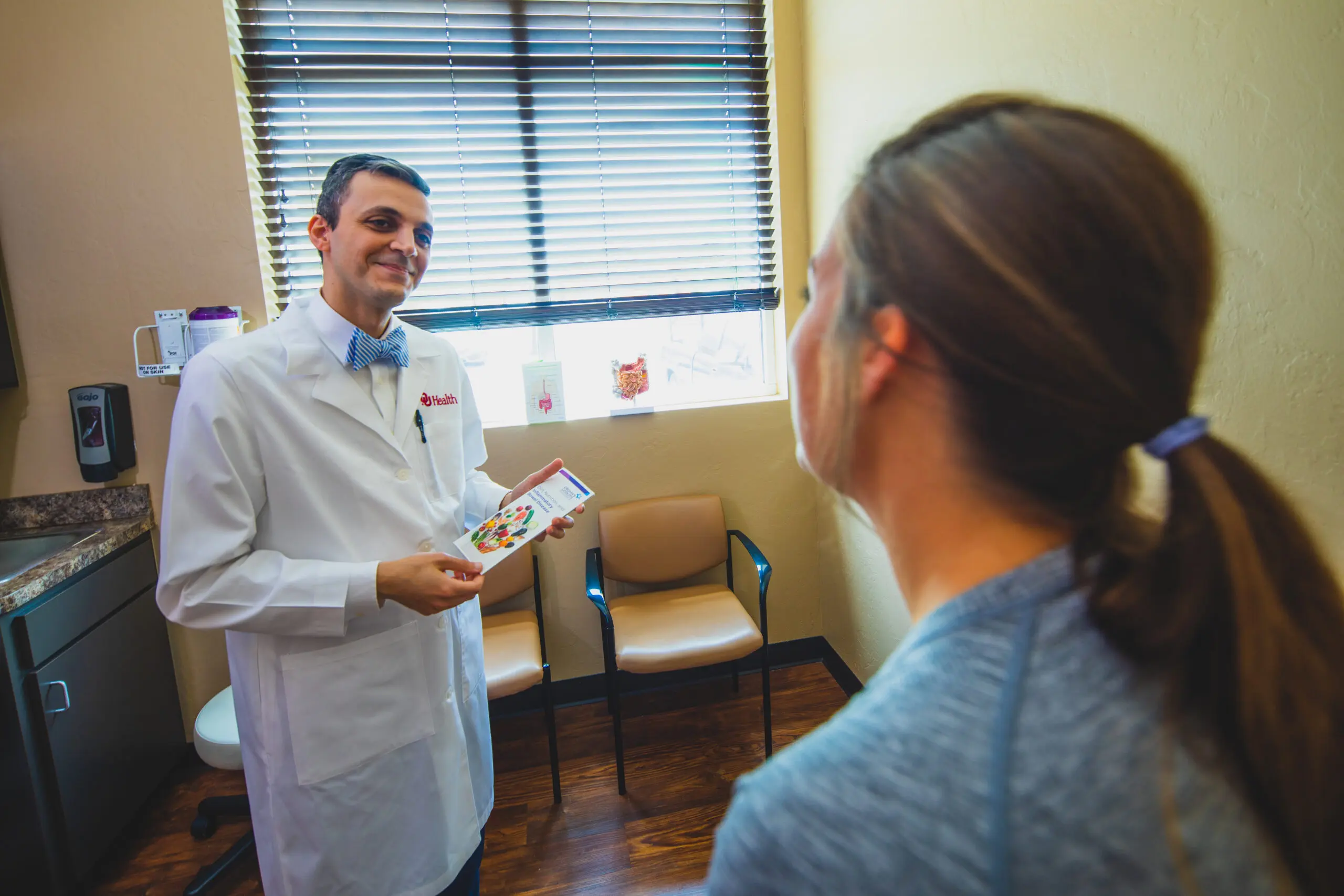Physical Health: Reaching Your Goals
When beginning a new exercise routine, you may have specific goals in mind. Maybe it’s to lose weight, build strength or improve your overall health. Stillman Brown, an outpatient physical therapist with Ascension St. John in Tulsa, says all exercise is good exercise, but depending on your goals, certain activities are better for the outcomes you desire.
Strength, Balance & Endurance

“If you’re looking to increase your strength, then resistive training – with weights or just your bodyweight – is most efficient,” he says. “If you’re looking to increase your ability to walk, run, bike or swim longer, then cardiovascular training is the place to start. If you want to improve your balance, then balance-specific training is ideal.”
However, if you’re concerned about your balance, Brown says the best thing to do is see a physical therapist.
“We are specially trained to evaluate and help people improve their balance,” he says. “Balance arises from three different systems in your body: your vision, inner ear and the sensory nerves in your feet, and if there’s a deficit in any of those it can impair your balance overall.”
He adds the caution that if you’re one to try the trending balance exercises found on TicTok or YoutTube – then be sure to be safe.
“Always practice balance with your hands hovering over something stable, like a countertop or the back of a sofa,” he says.
Brown also shares how cardio and strength training go hand-in-hand. He says being stronger helps your cardiovascular performance and being in better cardiovascular shape improves your ability to strength train – and strength and cardiovascular capacity both contribute to good balance.
“The foundation of a strong body is a strong core, but if you’re not already in the fitness or healthcare industry, there’s a lot of confusion about what the ‘core’ is,” he says. “Most people assume the ‘core’ is just your abdominals, but it’s much more than that. Simply put, imagine your body is a barrel. The sides of the barrel are wrapped in muscles – your abdominals, obliques and back extensors – and those need to be strong in order to support your trunk, hips and extremities when you get out of bed in the morning, walk to your car, lift something and so on.”
And he’s quick to point out that strengthening your core doesn’t just mean working toward a six pack for the pool.
“A physical therapist, athletic trainer or even a Google search for ‘deep core exercises’ can help you strengthen the deep, stabilizing muscles you need to prevent back and hip pain for the long haul,” he says.
When you’re wanting to improve your endurance in any activity, whether it’s cardiovascular or muscular, Brown says you simply have to do more of it consistently.
“That said, any time you increase your amount of exercise, be sure to listen to your body,” he says. “Soreness after a workout is okay. Pushing through pain to increase your endurance is never a good idea. A sudden increase in training volume, whether it’s the number of miles you walk every week or the amount of weight you’re lifting, can lead to overuse injuries. Increase bit by bit and don’t forget to take time to rest and recover.”
Flexibility
“Flexibility is an important part of fitness, particularly as we age,” says Brown. “With each decade of life, the soft tissues in our bodies gets stiffer and more rigid, and remaining flexible becomes important to maintain upright posture, good breathing and the ability to move, reach and do things.”
He says he’s not a big fan of static stretching – such as bending to touch your toes for 30 seconds – unless there’s a specific issue needing addressed.
“To maintain flexibility, I want people to do dynamic, gentle movements that bring them to the limit of their tissue length,” he says. “Things like yoga, elliptical, fitness classes or aquatics are perfect.”

Weight Loss
“I tell my patients every day: weight loss is about what you eat,” he says. “To burn off a typical 200-calorie donut, you would need to walk briskly for 45 minutes, jog for 25 minutes or bicycle hard for 20 minutes. Imagine that! Exercise can absolutely help you work out, but diet is the single most important factor.”
Brown says if you have any questions or concerns about reaching your physical goals, never hesitate to visit a physical therapist.
“Most people don’t realize you can refer yourself to a physical therapist without an order from your doctor and get treatment for up to 30 days,” he says. “We are always here to evaluate, advise and treat people to help them reach their physical potential.”
Mental Health: What We Know
Mental Illness
While more Americans struggle with mental illness than ever, more people are also seeking help.
The National Alliance on Mental Illness reports an estimated one in five U.S. adults experience mental illness. Britta Ostermeyer, M.D., MBA, chief of psychiatry at OU Health in Oklahoma City, says this concerning statistic is actually nearing one in four.
“The numbers are alarming, because mental illness can have wide-ranging impacts on an individuals’ quality of life, relationships and overall well-being,” she says. “Additionally, the prevalence of mental health issues is expected to rise in the future, with more people likely to experience symptoms at an earlier age. Early intervention and increased access to mental health care will be essential in addressing this growing concern.”
Noting another distressing statistic, Ostermeyer says that U.S. suicide rates have increased nationwide by approximately 30% over the past two decades. Along with the urgent need for better early detection of mental health issues and improved access to mental health services, she says an equally important need is to reduce the stigma surrounding mental illness.

“Today, nearly every family is touched by mental health challenges, regardless of background or socioeconomic status,” says Ostermeyer. “Mental health conditions affect people from all walks of life, and we need to normalize these conversations. We need to talk about mental illness like we talk about diabetes and heart disease.”
She says depression and anxiety, in particular, have increased.
“The complexities and uncertainties of today’s world have made life especially challenging for youth,” she says. “We had to make it through the isolating and traumatic experience of the COVID-19 pandemic, along with ongoing global issues like war, climate change and economic instability. These challenges are contributing to the rise in mental health struggles among young people.”
Good News: Progress & Research
Despite the increase in mental health issues, some good news is that more people are seeking mental health services, and there is greater openness about discussing mental illness, especially among younger generations.
“We’ve also made significant progress in the treatment of mental health and psychiatric disorders,” Ostermeyer says . “There are now more medications available of various types than ever before in history. In addition to traditional medications, there are several innovative treatment options: treatment with Ketamine nasal spray or infusions, treatment utilizing electromagnetic waves using Transcranial Magnetic Stimulation (TMS), and in very selective cases, the gold standard of psychiatric treatment, which is Electroconvulsive Therapy (ECT) – only utilized as a last resort for certain severe conditions and safely performed in a hospital setting with an anesthesiologist, who puts the patient to sleep. In addition, we have different types of psychotherapies that are very helpful when added to biological treatments of medications or Ketamine and interventional psychiatric treatments, like TMS or ECT.”
The Frontiers of Addiction
Ostermeyer adds that significant advancements have also been made in understanding and treating addiction.
“Addictions or substance abuse disorders are biological brain disorders, and there are several new treatments utilizing medications with conjunctive counseling to help manage cravings and facilitate abstinence from the drug the person is addicted to,” she says. “At OU Health, we have the CARES Clinic, which specializes in the treatment of addiction, offering a comprehensive approach to recovery.”
Set to open at the end of 2026, construction has begun on the OU Health Behavioral Health Center, which will provide critical mental health support for youth and families in Oklahoma.

“We are grateful to our Oklahoma legislators for making this important development possible,” says Ostermeyer. “It will bring much-needed care, hope, and healing to the community.”
If you or a loved one are suffering from mental health issues, she encourages you to take advantage of available mental health services.
“The stigma surrounding mental illness has decreased significantly, and insurance now covers many mental health treatments,” she says. “Providers are more committed than ever to helping individuals, and there is now a wide range of effective medications and treatment options available as mainstream therapies. It’s important to seek help when needed – there are resources and support systems in place to assist everyone on their journey to better mental health.”
The Importance of Dental Health
If you always brush your teeth on-the-go then you may not be meeting the recommendations by the American Dental Association (ADA). The ADA recommends brushing your teeth twice daily with fluoride toothpaste for two minutes. To reach the two-minute mark, they say divide your mouth into four quadrants – top left, top right, bottom left, bottom right – and spend 30 seconds brushing each area. Flossing is also essential to your daily routine to remove the hard to reach plaque that builds up between teeth – which is the primary cause of gingivitis.
Maintaining good oral health can have long-term effects on your physical health. The Oral Health Foundation reports that bacteria from gum disease can enter the bloodstream and produce a protein which causes the blood to thicken, potentially resulting in an increased risk of heart attack.
In addition, having healthy teeth and gums can reduce one’s risk of certain cancers and dementia. According to the Oral Health Foundation, recent research shows that women between the ages of 54 and 86 with a history of gum disease were 14% more likely to develop cancer and individuals with healthy gums are 70 percent less likely to develop Alzheimer’s disease than those who’ve suffered from gum disease for a long period of time.

The Importance of Hydration
Staying hydrated has become a trending topic with the variety of products available claiming to rapidly increase one’s hydration. Liquid I.V., for example, which comes in single-serve packets, boasts to contain three times the amount of electrolytes than the leading sports drink, and offer faster hydration than water alone. However, there’s much debate over the need for these additional water-enhancing products.
Approximately 60 to 70% of our body weight is water and it’s a critical component of our physical health, as it helps regulate body temperature, aids in digestion, protects body organs and tissues and promotes good kidney function. While there are exceptions based upon your age, body weight and environment, the general recommendations for fluid intake is nine cups of fluid a day for women and 13 cups of fluid for men. Healthier options when taking in fluid is to choose water or other low-calorie beverages. Many popular sports drinks, sodas and coffees contain an excess of sugar and can be high in calories. In addition, the general consensus of experts regarding the need for additional electrolytes depends upon your activity level.
Water should be fine to hydrate before, during and after low-to-moderate intensity activities lasting less than an hour. However, for high-intensity activities that extend beyond an hour, consider
grabbing your favorite electrolyte-enhanced
beverage to stay hydrated.

Sleep: How to Master the Art
Struggling with poor sleep can have a dramatic effect on one’s health. According to the National Institutes of Health, sleep deficiency is linked to many chronic health problems such as heart disease, kidney disease, high blood pressure, diabetes, stroke, obesity and depression. In addition, the Centers for Disease Control reports that approximately one-third of U.S. adults don’t get enough sleep – with experts recommending between seven and nine hours a night for adults.
To help you achieve a better night’s sleep, the National Sleep Foundation offers the following tips:
- Go to sleep and wake up at the same time every day, including weekends.
- Create a relaxing bedtime routine, such as listening to calming music, reading a book or taking a warm bath.
- Make sure your bedroom is cool. Your body temperature naturally decreases to initiate sleep. A bedroom temperature between 60 and 67 degrees Fahrenheit helps promote sleep.
- Make sure your bedroom is quiet – turn off noisy distractions and/or silence unwanted noise with earplugs or ‘white noise.’
- Make sure your bedroom is dark.
- Sleep on a mattress and pillows that are comfortable and supportive.
- Finish eating meals 2 to 3 hours before bedtime.
- Exercise regularly.
- Limit the amount of caffeinated products you consume in the afternoon.
- Alcohol and nicotine in your body can disrupt sleep and can cause nighttime waking. For optimal sleep, skip them close to bedtime or altogether.





















